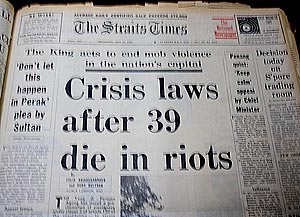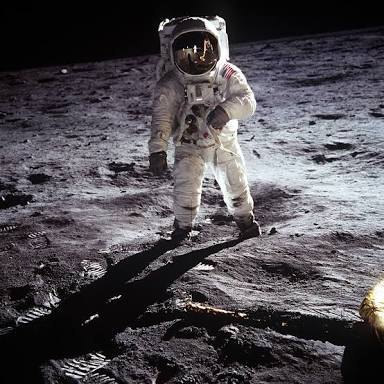From Wikipedia :
. On the morning of 13 May, Malays began to gather at the residence of Selangor Menteri Besar Dato' Harun Haji Idris in Jalan Raja Muda on the edge of Kampung Baru, although some were there as early as Sunday evening. The Malays came from various parts of Selangor such as Morib (Harun's constituency) and Banting, as well as parts of Perak.[14] According to the NOC official report, at around 6 pm, fist fights broke out in Setapak between a group of Malays from Gombak travelling to the rally and Chinese bystanders who taunted them, and this escalated into bottle and stone throwing.[15] News of the fighting then reached the gathering crowd in Jalan Raja Muda, and shortly before 6.30 pm, many Malays broke off from its rallying point at the Chief Minister's house and headed through adjoining Chinese sections.[7] The Malays, armed with parangs and kris, burned cars and shops, killed and looted in the Chinese areas;[7] according to Time, at least eight Chinese were killed in the initial attack.[16] Once violence broke out, it spread rapidly and uncontrollably throughout the city within 45 minutes,[1] to Jalan Campbell, Jalan Tuanku Abdul Rahman (Batu Road), Kampung Datuk Keramat, Kampung Pandan, Cheras and Kampung Kerunchi.[17]
Retaliations and armed response[edit]
According to John Slimming, who wrote an account of the riot in 1969, the Chinese were taken by surprise and did not retaliate for more than an hour.[18] The NOC official report, however, suggested that Chinese secret society elements had prepared for trouble and were in action when the violence started in Kampung Baru.[19] In Batu Road, Chinese and Indian shopkeepers began to form themselves into an improvised defence force, while a Malay mob attempting to storm the Chow Kit Road area were met with armed secret society gang members and ran.[15] The Chinese attacked Malays who were found in Chinese areas, and Malay patrons in cinemas were singled out and killed.[20] They also attempted to burn down the UMNO headquarters in Batu Road and besieged Salak South Police Station.
Early in the evening the rioters were met by police, who used tear gas in an attempt to control them. A 24-hour curfew for Kuala Lumpur was announced on the radio at 7.35 pm and repeated on television at 8 pm. Later, between 8.30 and 9.00 pm, a shoot-to-kill order was given by Inspector General of Police Mat Salleh. This was followed by another shoot-to-kill order from the Chief of Armed Forces, General Tunku Osman Jiwa.[21] The army was deployed and they entered the areas affected by rioting at around 10 pm.[22] Many people who were unaware of the curfew order were shot. Some were also shot while standing in their own doorways and gardens. Foreign correspondents reported seeing members of the Royal Malay Regiment firing into Chinese shop-houses for no apparent reason.[21]
By 5 am the next morning, the authorities at Kuala Lumpur General Hospital reported that there were about 80 dead. Members of the hospital staff also reported that the initial casualties between 7 and 8.30 pm had all been Chinese suffering from parang slashes and stab wounds, but that between 8.30 and 10.30 pm the victims were equally divided between Chinese and Malays. However, after about 10.30 pm the casualties were almost all Chinese, with nearly all of them suffering from gunshot wounds.[21]
Later events[edit]
The army gathered at crucial road junctions and patrolled the main streets, but even though a curfew had been announced, young men in areas such as Kampung Baru and Pudu ignored the order. Although most of the killings occurred on Tuesday night and Wednesday morning, the burning and looting of Chinese shops and houses by Malays continued on Thursday and Friday with over 450 houses burnt.[23] People displaced by the riots, most of them Chinese, were sent to official refugee centres in different parts of town - the Malays to Stadium Negara, and the Chinese to Stadium Merdeka, Chinwoo Stadium, and Shaw Road School. By Sunday, the number of Chinese refugees had increased to 3,500 in Merdeka Stadium, 1,500 in Chinwoo Stadium, and 800 in Shaw Road School, while the Malays in Stadium Negara had decreased from 650 on Thursday to 250 on Sunday.[24] Over a thousand refugees were still left in Merdeka Stadium a month after the riot.
https://en.wikipedia.org/wiki/13_May_Incident






